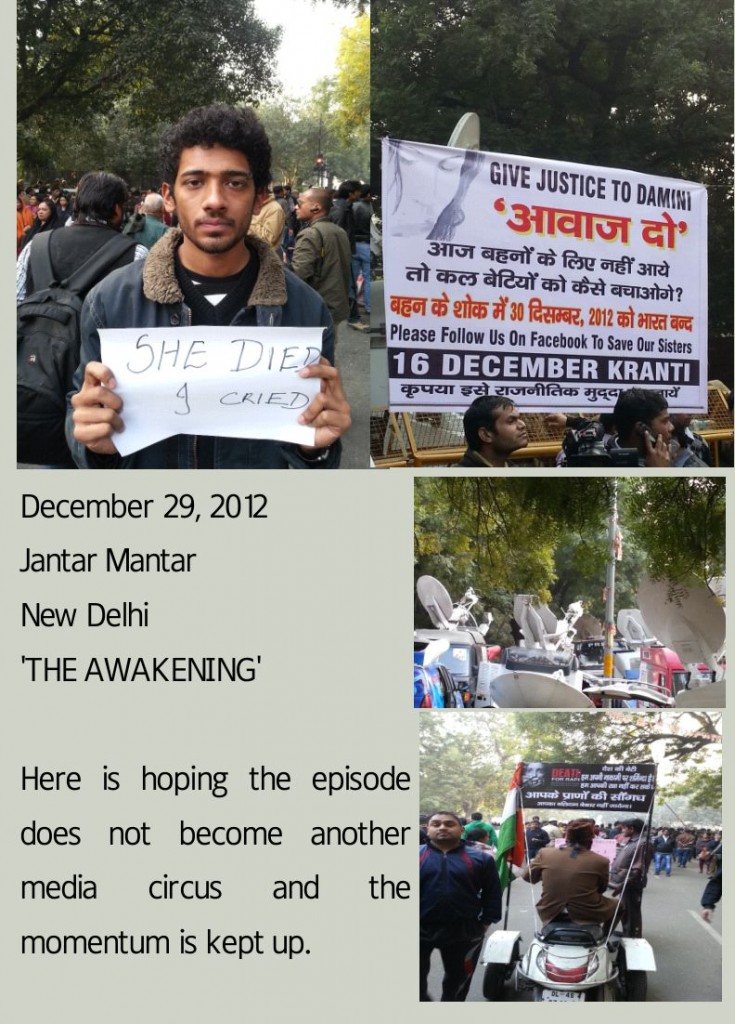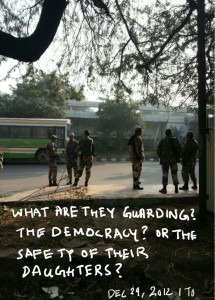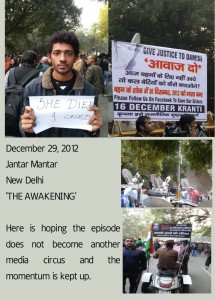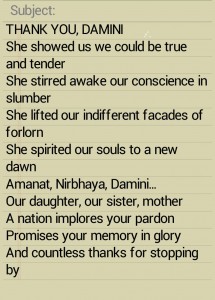December 29, 2012, New Delhi. ‘When the body and the brain give up, the heart takes over.’ I was pondering over this status update on Facebook when Damini died. She gave in to the diabolic assaults and rapes she sustained a fortnight earlier. ‘An abominable upbringing is no excuse for a monstrous adulthood.’ I vented my rage with my hopes for getting the noose for the ugliest set of criminals ever to inhabit the darker media. Then, writing about something you feel strongly about – or imagine vividly – makes you a columnist or a novelist of which I am neither. I wanted to do more. Heading to Jantar Mantar – the new epicentre of protests after the authorities, conceding cowardice and lack of apathy, cordoned off India Gate – I found thousands had already decided to do more before me.
There have been several lives which changed the living, some have left a greater impact with their deaths. India was never short on those who colossally revamped attitudes, moulded beliefs and primed conscience: Subhash Chandra Bose, Mahatma Gandhi, Bhagat Singh… The violence in their deaths seemingly proportional to the endurance of the legacy they left behind. Damini fought long and hard, courageously. ‘I want to live,’ she wrote in a note to her mother – her internals were vandalised with an iron rod – all way through her intestines to her esophagus. She was ravaged on the night of December 16th aboard a bus she boarded with her boyfriend after a movie; the pair was told that it was a plying public bus and the three seated males were passengers. In addition, there were two more who were the conductor and his helper. What the hapless couple had actually got into was a regular ‘fun ride’ the perpetrators got together for every Sunday – one fuelled by day-long alcohol binges culminating with picking up streetwalkers as night fell. Earlier that evening they had taken in other passengers, one of whom they had robbed of his wallet; the fares bought more alcohol and food. Violent protests on the first day following the gang rape saw the clamping down of section 144 at India Gate and surrounding areas which made coming together of a group, however small, illegal. As protests moved venue to the adjoining Jantar Mantar the civic guardians closed down all the nearby metro stations. But what they didn’t factor in was the profile of the average protester – the young India, or in long hand, those whose limbs did not grow weary or go creaky on wintry mornings. Paramilitary reinforcements were brought in by the truck full and deployed in key areas outnumbering the civilians giving rise to ‘where were they till now’ refrain. It was valid – if the country had might in such numbers, why couldn’t they be sent out to patrol the mean streets increasingly ‘menaced by the migrants’? The chief minister of the state had earlier blamed the rising atrocities against women in particular and crime rate in general to migrants. Though there was truth in what she said, she never uttered the ‘migrant’ word again. Understandable – they were a sizeable and growing vote bank and all the ruling class has to do was regularly regularise the illegally occupied public parks and river banks every five years. ‘She died, I cried’ wept a smallish placard; the chap holding it had a scruffy beard and a fashionable ear ring. He told me that he really cried when he heard the news; the watery eyes told me that he was still crying. We parted after a brief hug which lasted for a long time. There were protesters who were lying on the ground, unmoving, silent. Another one made a human chain and made their way through the swelling crowd only to be blocked at the first barricade by stern policemen wielding sterner lathis. The chain revolved around and zigzagged through the crowd for a while before dissolving away. Sloganeering students from Jawaharlal Nehru University made for a boisterous group; two well-built youngsters with long hair and wearing dapper jackets pumped their fists at the crowd to raise their pitch, theirs had already bellowed down to a scrape. A nukkad or street play group held forte with their staple battery powered public announcement systems – they sang and shouted, cried and chorused. In the midst of all this show of solidarity against sexual violence a woman journalist was groped in her buttocks. She turned around, gave the nonchalant guy a thwack across the arms. She looked away to holler out to her male colleague and the groper slunk away into the crowd.Sexual liberty of ancient India has been for ages aberrantly misconstrued as promiscuity and conveniently misinterpreted as equality. Kamasutra has been cited as a tome of tribute to the equality of men and women. You should pardon me if I am wrong for I am no social psychologist. But what I do know is that when it comes to sex, you need two persons, usually. Sex being a state where top, bottom or side are irrelevant – what matters is what it all sums up to – the dalliant woman was automatically bestowed with an equality which never even struck her as missing. The devadasi system of ancient India is further proof that man-woman equality was non-existent in sexually liberal ancient India; emperors having a thousand concubines point fingers towards the same postulate.
Movers and shakers of modern India and the elected and nominated youth representatives are people on the wrong side of their 50s. They were born closest to these dark ancient systems of accepted sexual norms, grew up fantasizing about harems and possibly kept a mistress or two. (Even today in some remote villages of Andhra Pradesh and Karnataka there are castes where the new groom should give his bride to the zamindar or land owner on the wedding night.) While one of these chosen lot decreed that the protesters were mostly women who were ‘dented and painted’ another one decried the rise of sexual crimes to skirts calling for banning skirts in schools. More than adding fat to fire, what made the statements sadder was that one of them was the son of the country’s president.My eyes locked with a number of those who had gathered there. A new language had been devised just for the occasion – one that was silent, wordless, spoken through moist eyes, understood with an imperceptible nod, lips sucked in. ‘Awakening’ was a word that was used much by the media over the following days – a word which was birthed and bandied about here, around me. Right here. The stands were extreme; posturing didn’t come in means. Profound was the times I was passing through. Many today bravely proclaim they were never worried about the Mayan predictions; a bravery that was missing till December 21st. What the Mayans did predict was the end of the world as we know it – meaning the beginning of one we never knew. Damini’s death was a hope in that direction, apocalyptic in an inward manner. A world where women are respected, taken care of, provided for and protected. Just calling them ‘amma’ or voting them to power or anointing them with authority will not help. Teaching school girls martial arts, even banning skirts are kneejerk at best, that mindsets can be changed is delusive. But it has to start somewhere. An overwhelming rally is to begin with the noose.
In India no hour passes by without three rapes – mostly unreported. An incident which elicited a hexed shrug at first to one which brought about a conviction that there are responsible takers for tomorrow – my anguish at Damini’s death metamorphosed into one of strange consolation. A girl in nearby Chandigarh was raped the very next day and committed suicide; I told myself Damini’s death wouldn’t go in vain. A 43-year-old woman was raped by two men around the same time. On New Year’s Eve, a 17-year-old school girl was raped by two men…No Damini, you didn’t have to die.
(The post is illustrated with my Facebook status over the course of the public upheaval following the crime, the police clampdown and the media frenzy. It’s one month today, the trials have started to public calls of boycotting the Republic Day celebrations on January 26 for speedy administration of justice.)
















